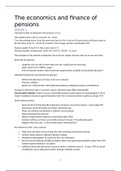Samenvatting
Samenvatting The Economics and Finance of Pensions
- Instelling
- Tilburg University (UVT)
Zeer uitgebreide samenvatting van het vak "The Economics and Finance of Pensions" Alle colleges worden besproken en sommige delen zijn in het Nederlands kort toegelicht ter verduidelijking (de rest van de samenvatting is wel in het Engels)
[Meer zien]




